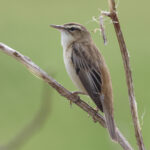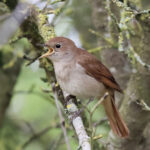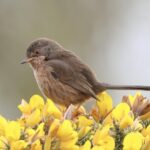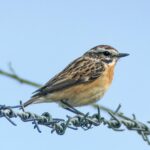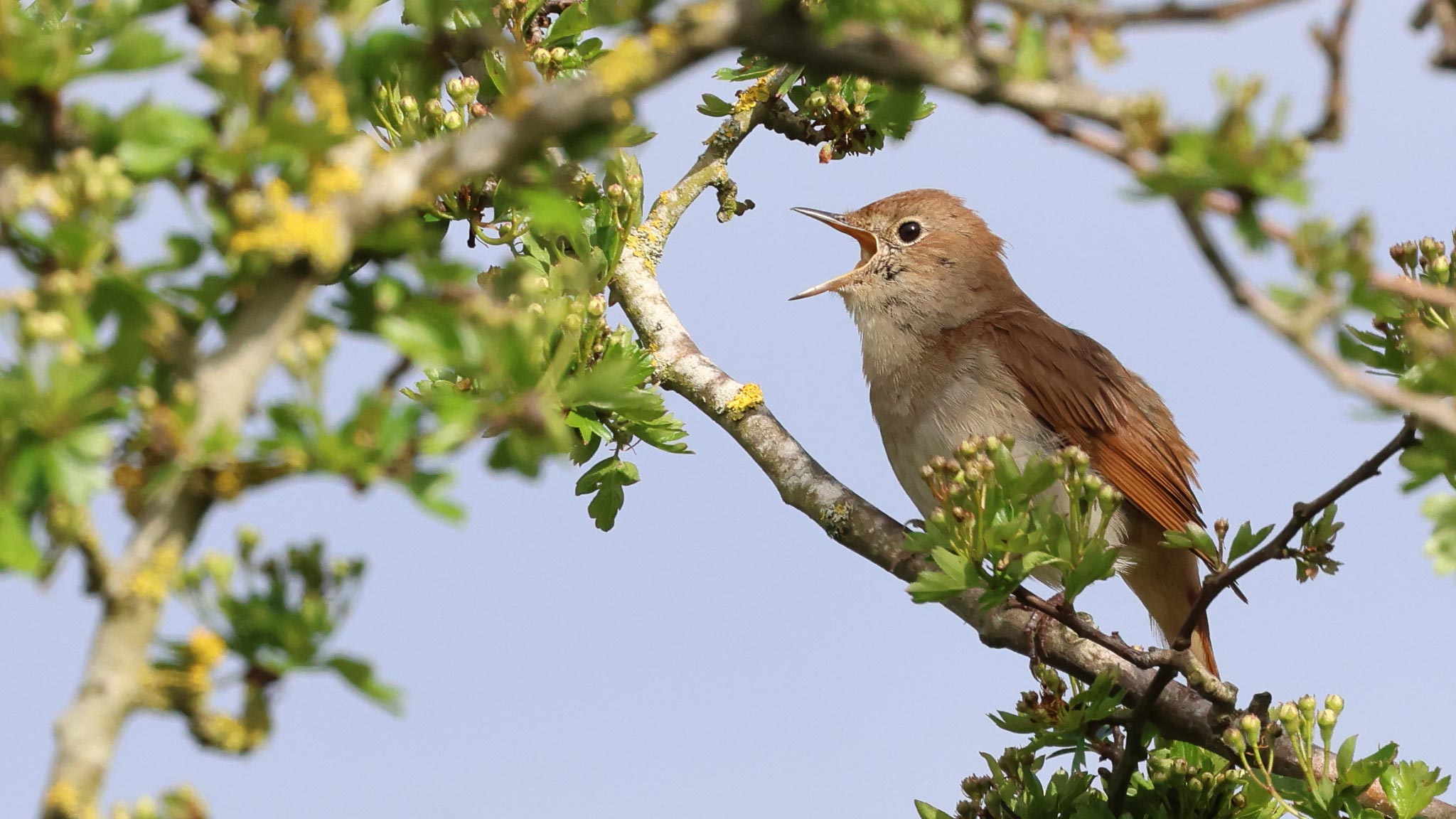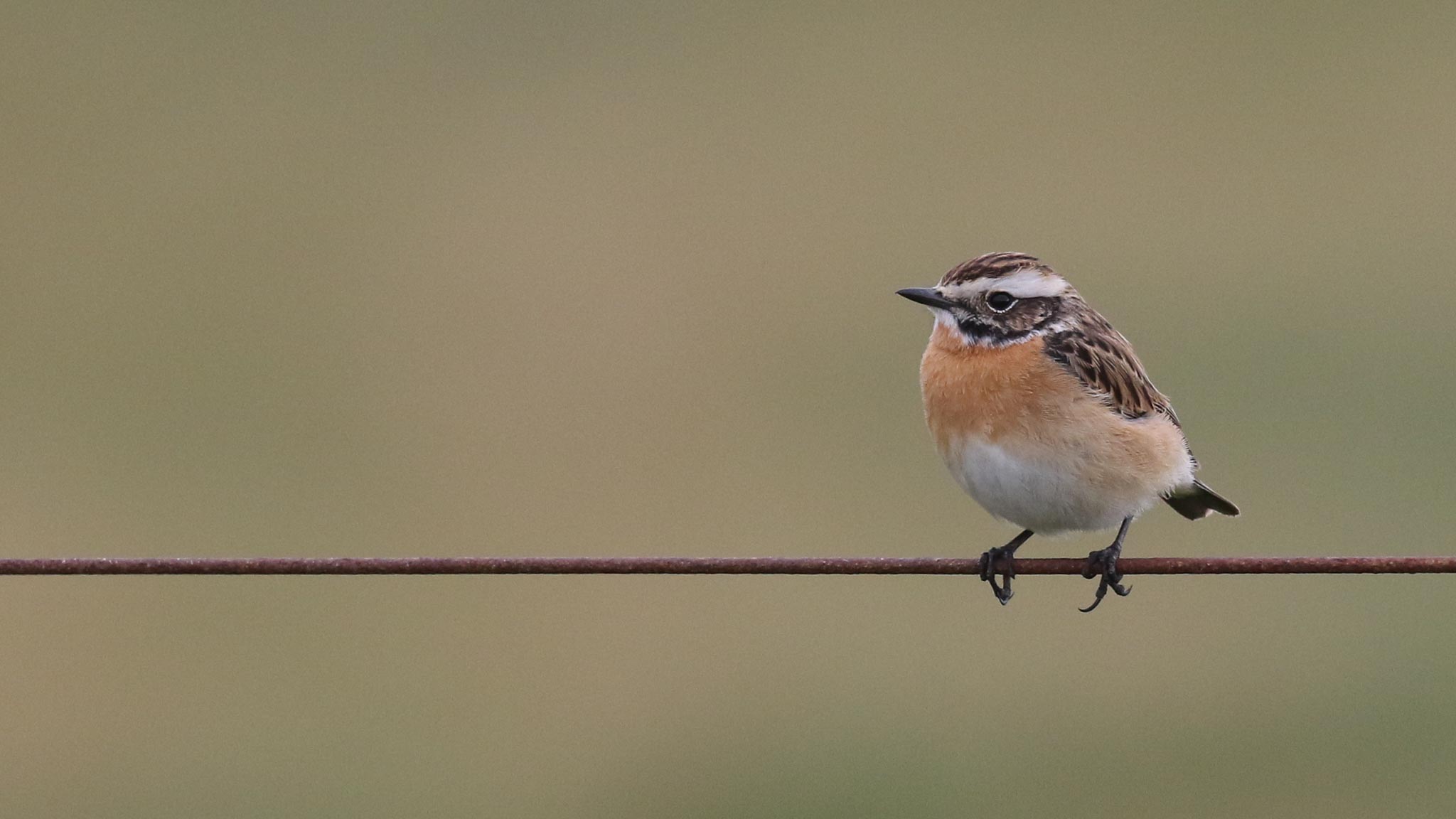Day 2 of a three day long weekend of Winter & Owl Tours, our final day. Once again, it was a frosty start and then a gloriously sunny winter’s day, great weather for being out. We headed up to north-west Norfolk today.
Our first destination was Titchwell, but on the way there we spotted a large flock of Brent Geese in a field beside the road. The winter wheat was coated with frost and they were huddled together in a tight group. We stopped for a quick look – they looked quite smart in the early sunshine.
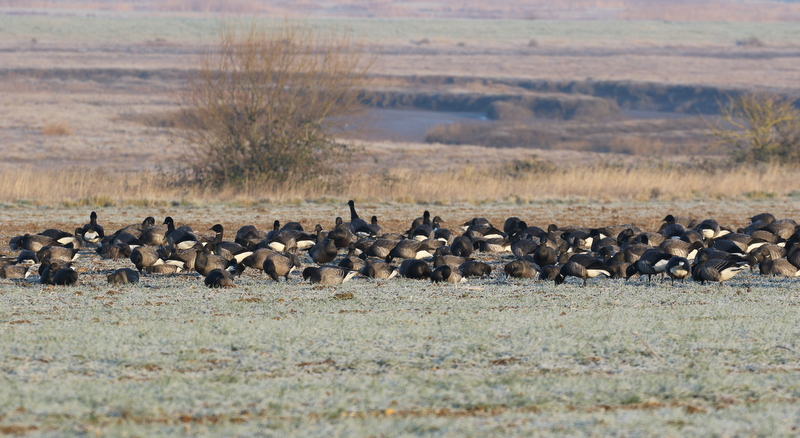 Brent Geese – huddled together in a tight flock on a frosty morning
Brent Geese – huddled together in a tight flock on a frosty morning
The car park at Titchwell wasn’t too full yet. A couple of Long-tailed Tits appeared on the sunny edge of the trees opposite as we parked up. Then we made our way down to the visitor centre. There were not too may birds on the feeders yet, a few tits and a Goldfinch or two, but more action below where several Moorhens, Blackbirds, Dunnocks and Chaffinches were tidying up the spillage.
There were a few birds up in the alders nearby, mostly Goldfinches. But a careful look through revealed a Redpoll. It was quickly joined by three more. We got them in the scope and confirmed they were Mealy Redpolls, quite pale around the face, grey brown above with prominent pale lines down the middle of their mantles and, when they hung upside down and parted their wings, we could see the pale ground colour to their rumps. One was a smart male, with a lovely pink wash on its breast, in addition to the darker red poll on the front of its head.
 Mealy Redpoll – four were feeding in the alders by the visitor centre
Mealy Redpoll – four were feeding in the alders by the visitor centre
 Mealy Redpoll – one of the four was a very smart pink-breasted male
Mealy Redpoll – one of the four was a very smart pink-breasted male
When the Mealy Redpolls flew back away from us through the trees, we set off onto the reserve. A careful look in the ditch by the path revealed a Water Rail. We watched it for a while, digging in the leaf litter on the side before running further along in the water in the bottom. While we were standing there, a Sparrowhawk zoomed low through the trees only a few metres in front of us.
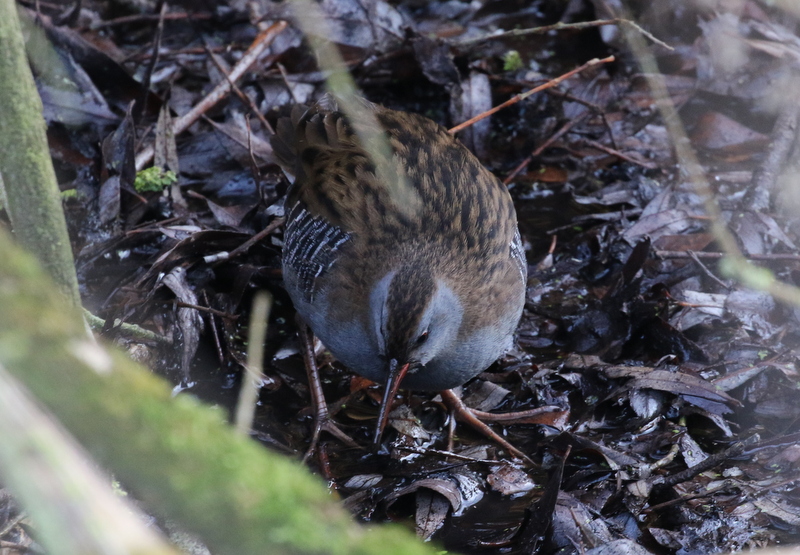 Water Rail – in the ditch by the main path
Water Rail – in the ditch by the main path
As we came out of the trees, the reserve was quite a picture, with the low winter sun catching on the tops of the reeds. A quick stop by the now dry again Thornham grazing marsh pool revealed a single Water Pipit feeding out on the mud. We had a good look at it before it wandered over to one side and disappeared into the rushes.
On the other side of the path, the reedbed pool was almost completely frozen. A pair of Mute Swans had managed to crack through the ice and created a small pool for themselves right in the middle. A Marsh Harrier circled up out of the reeds at the back. We heard a Cetti’s Warbler sing half-heartedly from the brambles in the reedbed and looked across just in time to see it fly down and disappear into the reeds.
The freshmarsh was also almost completely frozen. A Little Grebe was diving in the one area of open water around the tallest island over in the back corner. It was surrounded by ducks – Mallard, Gadwall and Teal – also trying to feed. More ducks were standing around in groups on the ice, sleeping.
A large flock of waders flew up from the fenced off island. We could hear Golden Plover calling and a couple of smaller groups broke away from the larger numbers of Lapwing and headed off inland. With the water levels still very high on here, there were not very many islands left poking out of the ice. A small muddy remnant over towards Parrinder Hide held three Ringed Plover, as well as a few Lapwing and a lone Golden Plover. Otherwise, that was about it for waders on here today, not a surprise given the ice.
 Bar-tailed Godwit – our first of the day, on the Volunteer Marsh
Bar-tailed Godwit – our first of the day, on the Volunteer Marsh
There was more to see on the Volunteer Marsh, though that too was fairly icy today, despite the salinity of the water on there these days. A Bar-tailed Godwit seemed to be finding plenty of food in the mud, despite it sliding around on the ice. A couple of Knot down on the edge of the channel below the path were joined by two Dunlin, giving us a nice opportunity to compare them side by side. There were also a couple of Grey Plover and several Redshanks on here.
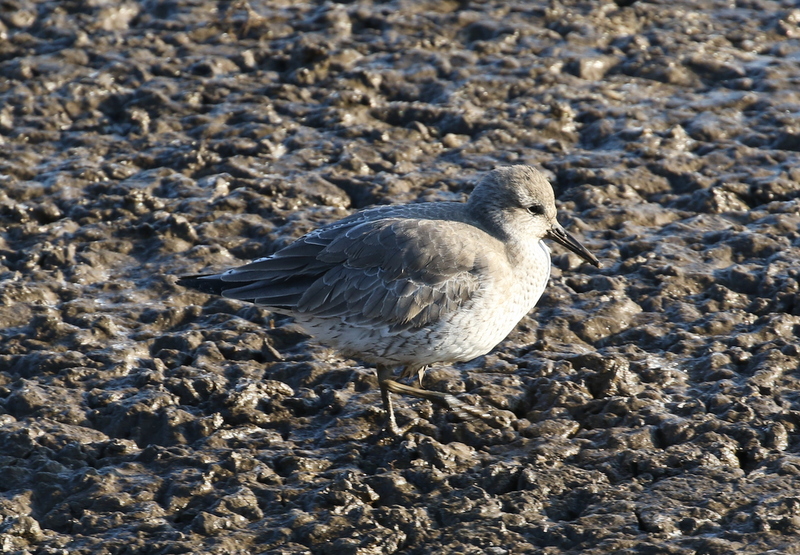 Knot – one of two along the edge of Volunteer Marsh today
Knot – one of two along the edge of Volunteer Marsh today
More birds were hiding out on the Tidal Pools, which had not frozen. The Avocets had come on here from the freshmarsh, about 13 of them braving out the winter in Norfolk, and they were sleeping on the spit at the back. There were also more godwits on here, as well as a few more Bar-tailed Godwits there were a couple of close Black-tailed Godwits too, always good to get a chance to compare these two very similar species.
There were more duck on here than usual, lots of roosting Teal and Shoveler around the edges. Over towards the back, we could see several Pintail asleep too. The Little Grebes are always on here in the winter, but they were very close to the path today. We watched them diving, puffing out their feathers when they surfaced and then flattening them down again just before going back underwater.
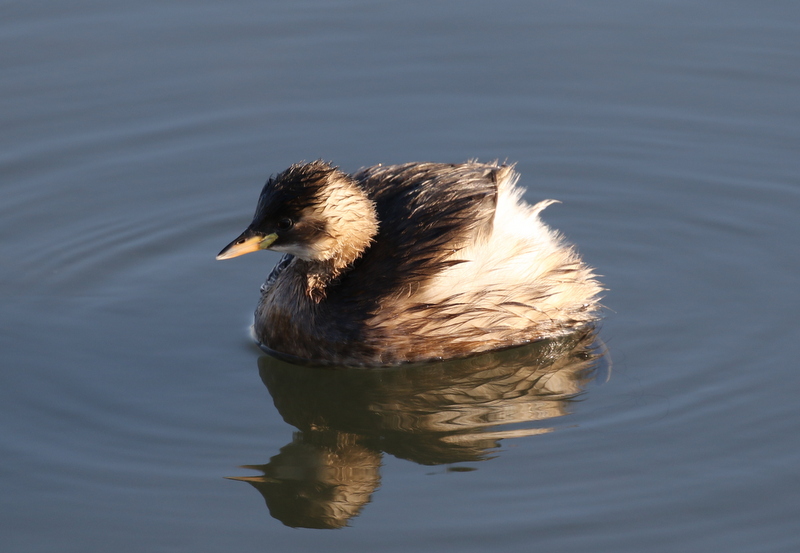 Little Grebe – diving close to the main path on the Tidal Pools
Little Grebe – diving close to the main path on the Tidal Pools
Our main targets here today were out at the sea. We stood up in the dunes with the sun on our backs and scanned the water. There have been good numbers of sea duck here in recent weeks and counts have continued to climb in the last few days. They were a little distant today, but we were not disappointed. The first thing we saw were the Long-tailed Ducks. They were hard to count, as birds were diving constantly, but there were at least 100 all together in one enormous raft, probably more. In recent years, numbers of wintering Long-tailed Duck in Norfolk have been quite low, so to see this many together is a real treat.
Further out we could see a huge raft of scoter. They would be predominantly Common Scoter, but they were too far off to sort through properly. Thankfully, there was a long line of much closer birds. Again, they were mainly Common Scoter but looking through them carefully, we could see a good number of Velvet Scoter with them too. The female Common Scoter have extensive pale cheeks, but the female Velvet Scoter have two smaller white dots on their faces. On some, you could also see the white wing flash on the Velvet Scoter and one helpfully flew past, showing off the white patch in the wing perfectly.
In with the closer group of scoter was a single Scaup. It was a first winter drake, its upperparts now quite extensively grey as it gradually moults out of its brown juvenile plumage. We could also see a few Goldeneye scattered over the sea. Four Common Pochard flew round out over the rafts of seaduck, presumably looking for somewhere to go, with so much water inland frozen over.
There were plenty of Great Crested Grebe out on the water, but one of the reserve volunteers picked up a couple of smaller grebes with them, two Slavonian Grebes. We had hoped to see some divers too, but they were all rather distant. There were a few Red-throated Divers moving again, but eventually we located a single Black-throated Diver on the sea. Even if it was a long way off, we could see the distinctive white rear flank patch between dives.
That seemed like a great selection of birds for the sea, so we decided to make our way back. As we passed the Volunteer Marsh, a Kingfisher whizzed in from the saltmarsh and disappeared away over the mud, too fast for everyone to get onto. Thankfully, as we were almost back to the grazing marsh pool, another Kingfisher flew right past us and dropped down into one of the channels on the saltmarsh. Again, they were probably looking for places to feed with much of the fresh water frozen over.
There was a small crowd on the main path staring out at the saltmarsh, so we stopped to look. Down in the grass, we could see a Jack Snipe. They have a very distinctive feeding action – bobbing up and down all the time, as if their legs are on springs – so we knew immediately what it was. Through the scope, we had a great view of it.
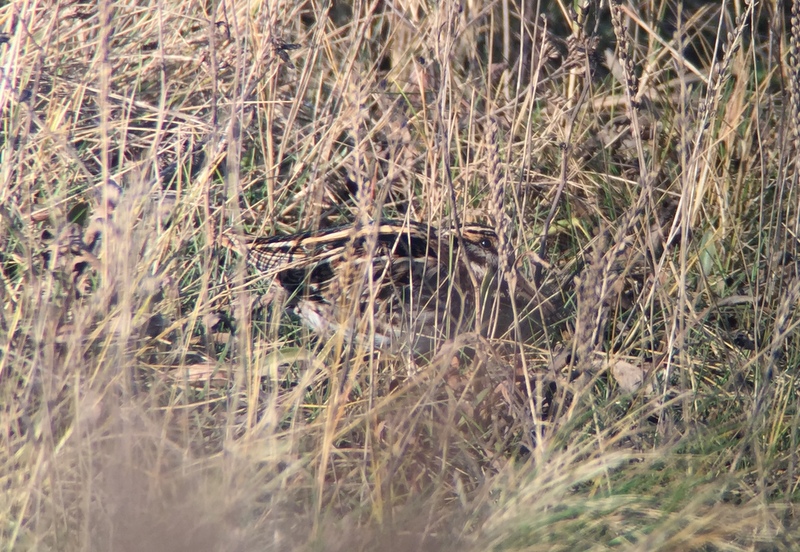 Jack Snipe – feeding out on the edge of the saltmarsh
Jack Snipe – feeding out on the edge of the saltmarsh
Then it was back to the car, stopping briefly to admire another Water Rail on the other side of the path to the one we had seen earlier this morning. There were also two Muntjac under the sallows and while we were looking at them, yet another Water Rail scurried past.
It was already lunchtime, but we decided to drive the short distance to Thornham Harbour and eat there. We couldn’t find any sign of the Twite around the harbour, but it was perhaps not a surprise as it was unusually busy here today, with lots of people out for a walk in the winter sunshine. We did hear a Spotted Redshank calling and turned in time to see it fly round over the saltmarsh and drop down out of view. Another Kingfisher was perched on a mud bank out along the edge of the harbour, glowing electric blue in the sun.
After lunch, we walked out along the bank towards Holme. When we got out to the dunes where we could look out over Broadwater, we were not surprised to find that it was mostly frozen. A few ducks, mostly Mallard and Gadwall, were sleeping around the edge of the reeds. There were more ducks further over, but the light was not so good from here – we were looking into the sun. Still, we could see a nice selection, including a few Tufted Ducks and Common Pochard. But there was no sign of the Ferruginous Duck from here, so we decided to walk round to the other side of Broadwater for a better look.
From round on the boardwalk by the NOA Car Park Hide, it didn’t take us long to find the Ferruginous Duck. It was asleep at first, over by the edge with all the other ducks, but we could see its distinctive rust-coloured body plumage and bright white undertail. Even with its head tucked in while sleeping, it would open its eye occasionally and we could see the white iris. Then it was disturbed by one of the Mallards and woke up, swimming out into the middle of the water to join the local Tufted Ducks. It didn’t stay there long and promptly swam back to the bank and went back to sleep.
 Ferruginous Duck – woke up and swam out into the middle with the Tufted Ducks
Ferruginous Duck – woke up and swam out into the middle with the Tufted Ducks
Ferruginous Duck is a very scarce visitor to the UK, from southern Europe and further east. However, it is also a very common duck in captivity, and it is always hard to tell whether the ones which turn up here have come from the wild population or escaped from someone’s collection. Still, it is an interesting bird to see.
While we were watching the Ferruginous Duck, we could hear a Fieldfare calling. We looked round to see it perched in the top of a bush by the car park. We got it in the scope and had a look at it, but as soon as the camera came out, a Magpie hopped up through the bush and flushed it. It was a shame, as it looked very smart in the winter sunshine.
We walked back to the beach and stopped for a quick scan of the sea. One of the first birds we set eyes on was a Black-throated Diver. It was much closer than the one we had seen earlier at Titchwell. It was still hard to get everyone onto, as it was diving constantly, but we all got a really good look at it in the end. There was another first winter male Scaup off Holme too. We could also see quite a few Red-breasted Mergansers out on the water and a small group of Eider. A close-in Guillemot was nice to see too.
There were a few seals out to sea as usual. We could see a crowd gathered further along the beach to the east, on the edge of the water, but only when they moved round could we see that they had been surrounding a Grey Seal pup. We walked over and the crowd had largely dispersed as we arrived. The pup seemed to be breathing heavily and had shown no signs of moving when everyone had been so close to it, so we messaged one of the reserve wardens about it, just in case.
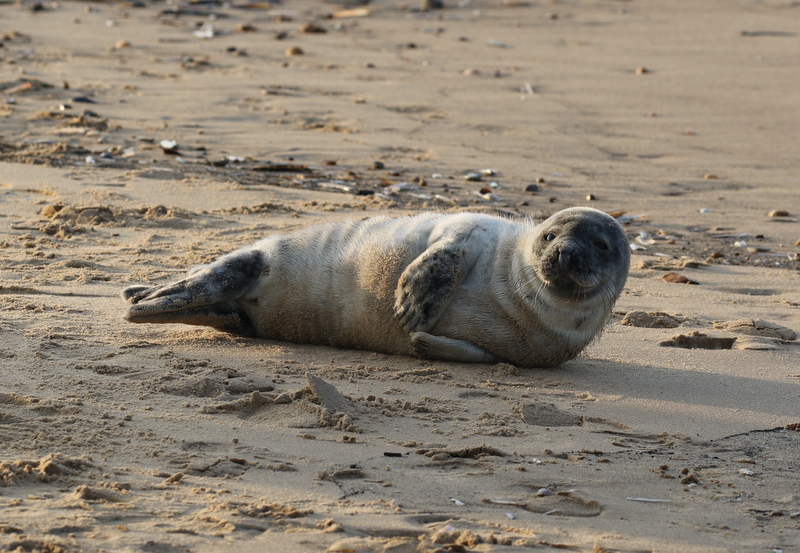 Grey Seal pup – on the beach at Holme
Grey Seal pup – on the beach at Holme
We left the seal pup on the beach and made our way back up through the dunes and along the seawall back to Thornham Harbour. There was still not sign of the Twite, but we did see a Greenshank in the harbour and a Stonechat perched on a bush by the seawall. Out across the grazing marshes, a Sparrowhawk was perched on a post in the distance.
The sun was already starting to sink in the sky and the temperature was dropping again. We made our way inland and started to drive round the farmland inland. We could see lots of Yellowhammers flying round in the hedges and so we pulled up in a convenient layby. In the small tree in the hedge nearby, we could see a single Corn Bunting – it was immediately obvious, given its much larger size. Then all the buntings flew and disappeared across the field behind the hedge.
We carried on our drive and eventually came to another place where lots of birds have been feeding in a plot planted with wild bird seed cover. The hedge beside the field was full of birds, masses of Reed Buntings and a good number of Yellowhammers too. We could hear Tree Sparrows calling and looked along the hedge to see several perched up with all the buntings, we counted at least eight there and at least another two calling in the hedge behind us. Tree Sparrows are an increasingly rare bird in southern Britain, so it was great to see them still clinging on here.
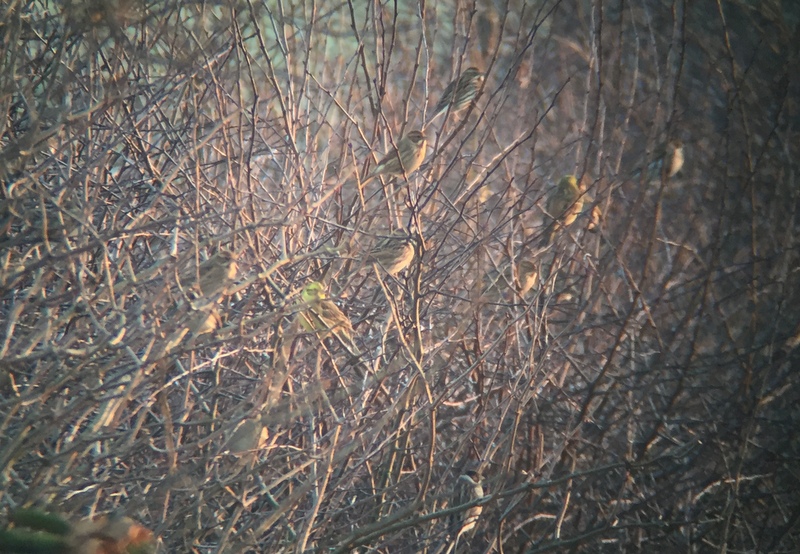 Buntings – the hedge was full of Reed Buntings and Yellowhammers
Buntings – the hedge was full of Reed Buntings and Yellowhammers
The birds in the hedge would gradually thin out, as they flew down into the field to feed. Then, periodically something would spook them and the field would erupt and everything would fly back to the hedge. When it did, we could see there were lots of Chaffinches here too, but they would fly up into the tops of the trees rather than into the hedge with the buntings.
It was great to watch all these birds – bringing back memories of how winter flocks in farmland used to be everywhere. But the light was starting to fade now as the sun began to set, so it was time to head for home, after a fantastic three days of winter birding.
